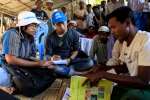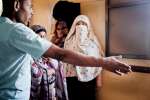- Text size
 |
|  |
|  |
| 
- Français
Ministers meet in Kampala ahead of African Union summit on displaced people
News Stories, 19 October 2009
KAMPALA, Uganda, October 19 (UNHCR) – Government ministers from across Africa gathered in Kampala, Uganda, today to address the challenges of forced displacement confronting the continent.
For the next two days, the ministers attending the extraordinary session of the African Union (AU) Executive Council will deliberate on the seemingly intractable problem of forced displacement in Africa, and lay the ground for the historic AU summit on refugees, returnees and internally displaced people (IDP). UN High Commissioner for Refugees António Guterres, currently visiting Rwanda, will represent the UN Secretary-General at the summit starting on Thursday.
The two-day summit, which will attract leaders from at least 36 African nations, is expected to adopt a Convention for the Protection and Assistance of IDPs in Africa. It will be the first legally binding international instrument on internal displacement having such continental scope.
Uganda Prime Minister Apolo Nsibambi told the delegates at Monday's gathering that after more than 50 years of independence from European colonial powers it was unacceptable that Africa continues to be world's biggest producer of refugees and IDPs. "The inability to effectively protect, assist and find timely solutions to the problems that created these displacement situations is posing a major threat to Africa's development . . . and has serious consequences [for its] peace and stability," he warned.
Sierra Leone's Foreign Minister Zainab Bangura said displacement was a scourge blighting the African landscape and the Kampala summit was a clear sign that it is "Africa's intention to take leadership and find solutions to our own home-grown problems."
And AU Commissioner for Political Affairs Julia Dolly Joiner said it was no longer possible to think that displacement can only be resolved with humanitarian assistance, adding that it required efforts that would lead to durable solutions.
"We are here to reflect on the specific challenges facing the displaced and adopt an instrument that would bridge existing policy and legal gaps, enhancing and supporting individual and collective actions by member states," she declared.
Chris Ache, UNHCR's representative to the AU, said he was heartened by the spirit of understanding and consensus emerging as the delegates got down to the main question on their agenda. "It is really encouraging to see Africa leading the way, taking ownership and tackling head-on the root causes of displacement, and finding the right solution," he said.
Many of the delegates were from countries that had recently emerged from conflict; several were former refugees and IDPs. They spoke passionately about the plight of the displaced and called for resolute African action.
"Let our minds reflect back on our brothers and sisters, the aged, our mothers, children and the infirm who are the first victims of forced migration. They have all their hopes on this summit that together we can lessen and/or end their misery," said Tarsis Kabwegyere, the Ugandan minister responsible for relief and refugee issues.
By Yusuf Hassan in Kampala, Uganda

















































